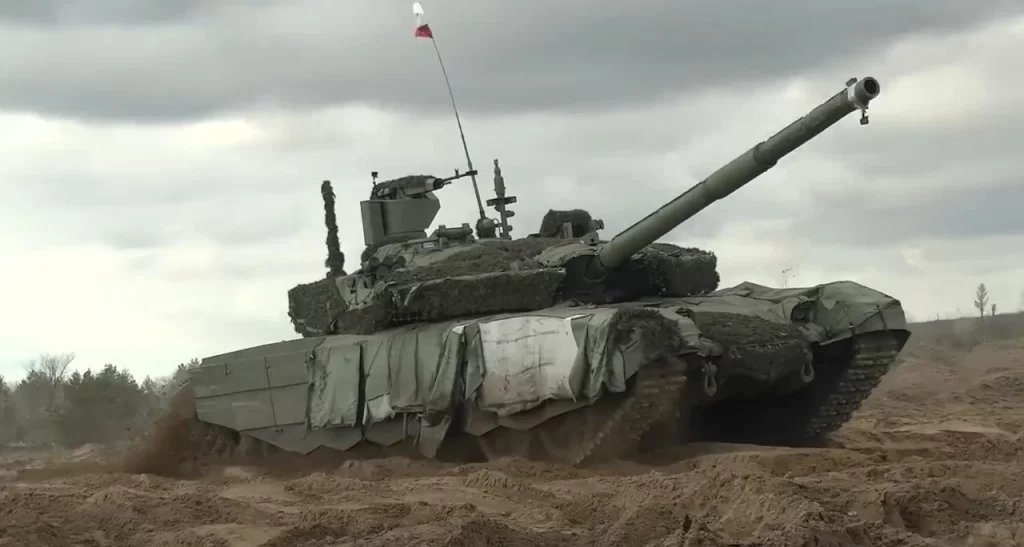Despite reports that Russia is using its cutting-edge tank, T-14 “Armata,” the CEO of the state business Rostec, Sergei Chemezov, has said that the tank is unlikely to be used against Ukraine despite its operational advantages over other tanks in Russia’s arsenal.
The CEO stated that the “Armata” is expensive, and although it is much more functional than existing tanks in the combat zone, the army is unlikely to use it in battle due to its high production cost.
“It’s easier for them to buy the same T-90,” Chemezov emphasised, adding that the state arms manufacturer needs funds to produce newer weapons. Right now, we need money to create new tanks, new weapons, more, maybe cheaper. So, if there is an opportunity to buy cheaper, why not?”
This should not come as a surprise. In July 2018, Russian Deputy Prime Minister Yuri Borisov stated that the country’s armed services do not intend to purchase the T-14 “Armata” tanks in bulk due to their high cost, preferring to improve the combat capabilities of existing military equipment through upgrading. Russian media said the Russian Ministry of Defence will use the T-14 “Armata” on the battlefield as a command post.
The T-90M Proryv (Breakthrough) is an updated variant of the Soviet T-90 MBT, which by the 1990s had already demonstrated innovative capabilities. Unlike its predecessor, the Russian version has a higher power-to-weight ratio.

The T-90 main battle tanks are Russia’s most advanced tanks after the T-14. They are now fighting against Ukraine and serving as the Russian army’s backbone. The T-90 is frequently compared to Western tanks like the M1A3 Abrams, Challenger-2, and Leopard-2.
From a perspective, the T-14 “Armata” tank will be a more formidable weapon than the T-90M “Breakthrough,” as the new tank will incorporate more advanced technologies to protect the combat vehicle.
The T-90M is like a bridge between the tanks of the past, produced in the USSR and then following Soviet standards, and the future, where, understandably, the ‘Armata’ and other military equipment capable of operating as drones—without drivers and crews.
Furthermore, the Russian army had plans to modernise its existing fleet of T-90 and T-90A tanks to the T-90M standards by the mid-2020s. But this appears unlikely now.
Both tanks have the same new multi-layered turret module with a 125-millimeter gun. The T-90M also features an automated fire control system called “Kalina.” Overall, this integration of tank technologies from the “Armata” to the T-90M allows for using a wide range of ammunition.
The fire control system of the “Armata” has a digital catalogue with typical targets and artificial intelligence, allowing the vehicle’s onboard computing resources to search for targets independently against complex terrain.
The T-90M “Breakthrough” tank with its combat turret module is the combat vehicle of today, while the “Armata” is the tank of the future. Work on the “Armata” continues to this day, and presumably, these tanks will enter service only by the end of the 2020s.
In terms of features, the T-90M is nearly identical to the “tank of the future” and the T-14 “Armata,” with just modest differences in driving performance and armour protection.
Be that as it may, the T-90M, not the T-14 Armata, is Russia’s main hope in confronting modern Western armoured vehicles. Deputy Head of the Russian Security Council Dmitry Medvedev highly praised the “Breakthrough” Tank in March 2023, “It is quite obvious that, for example, the same T-90M Proryv tank is our newest tank. But, in my opinion, this is now the best tank in the world. In the world! It is certainly better than Leopard, Abrams, including in its tactical and technical data, even in such a component as weight.”
On February 15, Russian President Vladimir Putin travelled to Nizhny Tagil to visit Uralvagonzavod, the country’s premier tank manufacturing company. The president met with workers during the visit and highlighted the defence-industrial complex’s responsibilities. Putin discussed the T-90M “Proryv” made by Uralvagonzavod. “The best tank in the world, without exaggeration,” the president declared. He said that both Russian soldiers and adversaries acknowledge it.
Tanks, including Western ones, are used as mobile firing units in this limited war. Tank fights, such as those fought on the Kursk Bulge or fast strikes by mechanised units deep into World War II forces, are not possible in the Donbas due to the possibility of unacceptable losses. Tanks are actually used as mobile firing platforms, from which you must shoot a few times before quickly changing positions to prevent artillery counterattacks. It is the reason the Russians deployed a large number of T-55s during the war, as they have a significant edge in terms of simplicity of deployment, operation, and repair.
